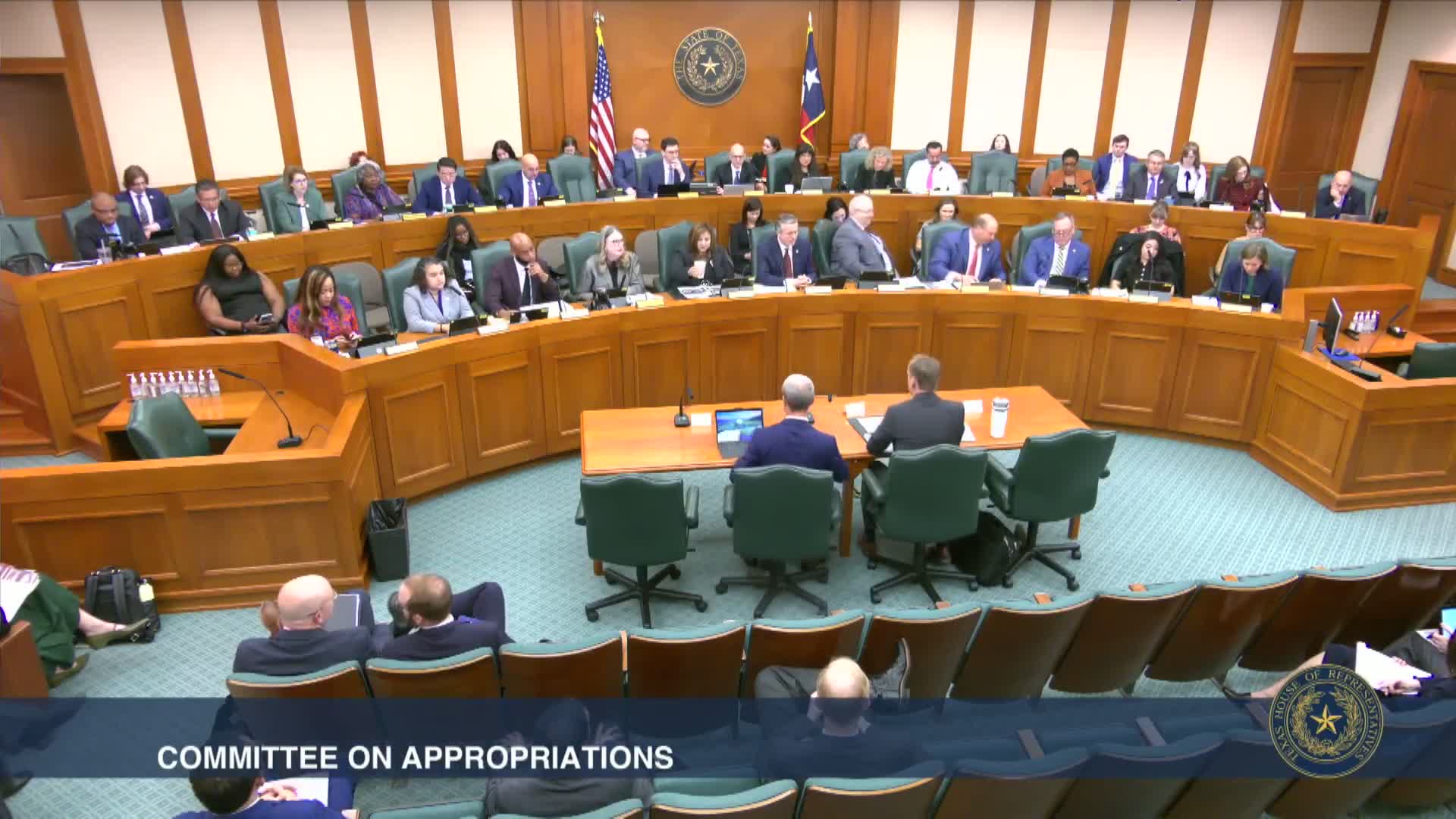LBB: House Bill 1 introduced, tax‑spending limit now controlling constraint
February 18, 2025 | Committee on Appropriations, HOUSE OF REPRESENTATIVES, Legislative, Texas
This article was created by AI summarizing key points discussed. AI makes mistakes, so for full details and context, please refer to the video of the full meeting. Please report any errors so we can fix them. Report an error »

Aaron Hendrickson and Kevin Cavanaugh of the Legislative Budget Board gave the committee a high‑level tour of House Bill 1 as introduced and explained how constitutional and statutory spending limits shape how much the Legislature can appropriate.
Hendrickson summarized funding in HB1 across budget articles, highlighting contingencies included in the introduced bill and several cross‑article priorities. Key points included full funding of the Foundation School Program and contingency funds for public education (including $4.85 billion of contingent education funding and $1.0 billion for an education savings account contingency), $5.0 billion for the Texas Energy Fund, and roughly $36.2 billion for highway planning, right‑of‑way, construction and maintenance.
Cavanaugh explained the three major spending constraints that apply to the appropriated amounts:
- Pay‑as‑you‑go limit: cannot appropriate more than the comptroller’s certified or projected revenues (LBB used the controller’s BRE figure of $194.6 billion for 2026–27);
- Tax‑spending limit: limits growth in non‑dedicated state tax revenue appropriations (the LBB set the growth rate at 8.93% for the coming biennium);
- Consolidated general revenue limit (statutory, effective last session): limits growth of consolidated general revenue (general revenue plus general revenue‑dedicated) appropriations to population plus inflation growth (LBB adopted 8.93%).
At the time of the introduced bill, the LBB told members the controlling constraint — the limit most likely to bind HB1 — is the tax‑spending limit, which LBB estimated had a capacity of about $4.8 billion for the 2026–27 introduced bill. LBB staff also provided the committee with a reconciliation across biennia and a list of “capacity” numbers that will be updated as the bill is amended.
Why it matters: understanding which statutory or constitutional limit binds helps appropriators decide how to prioritize new or contingent funding and whether structural changes (for example, to dedicate or re‑classify revenue) will be required to add new recurring appropriations.
Other highlights from the presentation
- HB1 as introduced shows roughly $2.8 billion (0.8%) increase in all‑fund appropriations compared with the latest estimated 2024–25 total on an all‑funds basis, with detail by article in the LBB packet.
- Funding in HB1 includes contingency appropriations that the LBB assumed for purposes of capacity calculations (for example, for school safety, a Texas University Fund expansion contingency, and Medicaid caseload increases).
- LBB staff offered technical assistance resources to committee members and offices during the session and noted how limits are computed and monitored as HB1 is modified through the process.
Ending
LBB staff said they will continue to update the committee as appropriations change and that the controlling spending limit can shift as HB1 is amended during session.
Hendrickson summarized funding in HB1 across budget articles, highlighting contingencies included in the introduced bill and several cross‑article priorities. Key points included full funding of the Foundation School Program and contingency funds for public education (including $4.85 billion of contingent education funding and $1.0 billion for an education savings account contingency), $5.0 billion for the Texas Energy Fund, and roughly $36.2 billion for highway planning, right‑of‑way, construction and maintenance.
Cavanaugh explained the three major spending constraints that apply to the appropriated amounts:
- Pay‑as‑you‑go limit: cannot appropriate more than the comptroller’s certified or projected revenues (LBB used the controller’s BRE figure of $194.6 billion for 2026–27);
- Tax‑spending limit: limits growth in non‑dedicated state tax revenue appropriations (the LBB set the growth rate at 8.93% for the coming biennium);
- Consolidated general revenue limit (statutory, effective last session): limits growth of consolidated general revenue (general revenue plus general revenue‑dedicated) appropriations to population plus inflation growth (LBB adopted 8.93%).
At the time of the introduced bill, the LBB told members the controlling constraint — the limit most likely to bind HB1 — is the tax‑spending limit, which LBB estimated had a capacity of about $4.8 billion for the 2026–27 introduced bill. LBB staff also provided the committee with a reconciliation across biennia and a list of “capacity” numbers that will be updated as the bill is amended.
Why it matters: understanding which statutory or constitutional limit binds helps appropriators decide how to prioritize new or contingent funding and whether structural changes (for example, to dedicate or re‑classify revenue) will be required to add new recurring appropriations.
Other highlights from the presentation
- HB1 as introduced shows roughly $2.8 billion (0.8%) increase in all‑fund appropriations compared with the latest estimated 2024–25 total on an all‑funds basis, with detail by article in the LBB packet.
- Funding in HB1 includes contingency appropriations that the LBB assumed for purposes of capacity calculations (for example, for school safety, a Texas University Fund expansion contingency, and Medicaid caseload increases).
- LBB staff offered technical assistance resources to committee members and offices during the session and noted how limits are computed and monitored as HB1 is modified through the process.
Ending
LBB staff said they will continue to update the committee as appropriations change and that the controlling spending limit can shift as HB1 is amended during session.
View full meeting
This article is based on a recent meeting—watch the full video and explore the complete transcript for deeper insights into the discussion.
View full meeting
